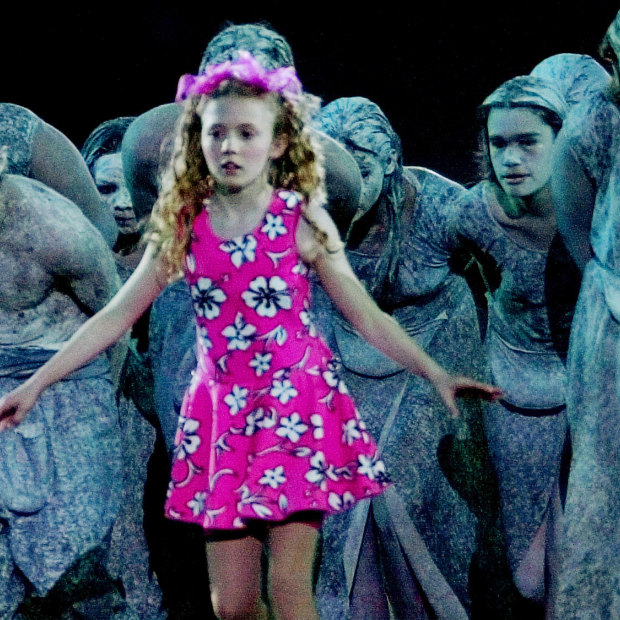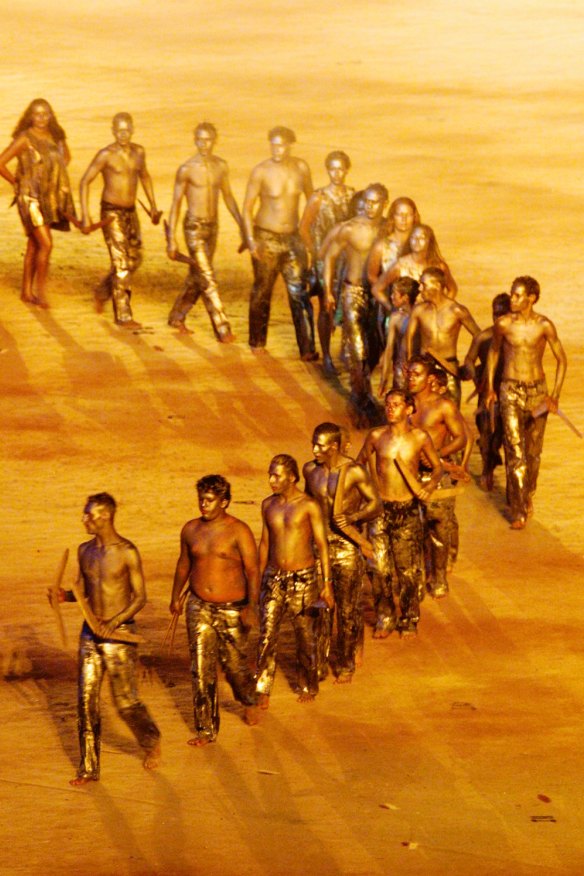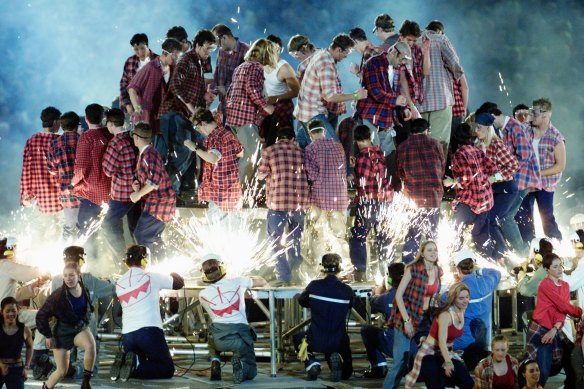This was published 4 years ago
From the archives: Seven secrets of the opening ceremony
This story was first published on September 16, 2000.
By Brett Foley

Nikki Webster, 13, performs in the Aboriginal sequence of the opening ceremony of the Olympics in Sydney.Credit: AP
Deep sea dreaming
Nikki Webster walks to the centre of the stadium, spreads out her beach towel and puts zinc cream on her nose. She falls asleep and is transported to a frenetic and brightly coloured dream of the sea. The visually stunning sequence features giant fish including barracuda, jellyfish, eels and squid, which swirl around the young girl, supported by overhead cables.
The cables also project Nikki and several swimmers wearing fluorescent bathers up to 32 metres above the ground. This sequence has the largest number of people ever raised overhead in an aerial performance, nine boys and girls and six specialist aerialists. A complex system of 11 cables strung 45 metres above the ground catapult the performers across the 111-metre space between the grandstands. More than 550 performers are involved in the sequence, designed to convey the significance of the ocean to Australia's development.
Awakening
Nikki is slowly lowered from overhead and disappears into a group of Awakening spirits. They lead her to Djakapurra, the songman, who calls to a new generation of spirits, which are drawn to the heartbeat of the land. Hundreds of dancers perform the welcome dance as red ochre fills the air. The Eora people welcome the Torres Strait Islanders as the drums beat and smoke from burning eucalyptus leaves cleanses the stadium, on land belonging to the Dharug people.
The sequence features more than 1,000 indigenous performers from the Central Desert, Arnhem Land, the Torres Strait, northern NSW and Sydney. It ends when a huge Wandjina cloth, 32 metres across, is raised and suspended from the overhead cables and encircled by eight stilt-walkers. The Wandjina, a creation spirit and law maker, then flings a lightning bolt to ignite bushfires to regenerate the land.

Indigenous performers at the Opening Ceremony in Sydney in 2000.Credit: Dallas Kilponen
Fire
The lightning sparks fire, which engulfs the arena. This signals 165 firebreathers, 20 flaming stilt-walkers and 40 flaming club swingers to assemble, making the largest number of performers breathing fire at once. They are accompanied by 20 percussionists as the group slowly moves forward exhaling plumes of up to four metres. They stop in the centre and breathe fire in unison, before moving, leaving blackened clumps of vegetation.
Nature
From the blackened vegetation, seeds slowly germinate into Australia's unique flora. The arena is eventually covered with waratahs, sturt's desert peas, waterlilies and banksias. Performers shimmer blue sheets of silk to signify water returning to billabongs, which encourages more flowers, such as honey myrtles, blue lechnaultias and swamp daisies, which grow and produce large canvases depicting Australia's unique fauna.
At the end of the sequence the lights dim and the floral creations become brightly illuminated, lighting up the stadium as European settlers arrive on a tandem cycle.
Tin Symphony
The settlers look in wonder at the departing flora and fauna. Under the theme of mechanisation, settlers progress through pioneering, to gold rush, to farming and finally the suburban quarter-acre. Dozens of Ned Kelly figures, as in Sidney Nolan's paintings, enter with guns blazing fireworks, followed by a 16-metre-high fire-breathing horse with a V8 engine, made from corrugated iron and old farm machinery.

The settlers tapdance their way through the opening ceremony.Credit: Steve Christo
The sequence is inspired by rural Australia and the machinery used to colonise the outback. More than 960 performers are involved, including gymnasts, aerialists and stockwhip-crackers. Finally a sheep-making machine produces boxes which open to reveal the final incarnation of the suburban man, with lawnmower.
Arrivals
This involves 2,000 children and 500 adults and depicts the arrivals of people from overseas 150 performers enter the arena on large floats which represent Africa, Asia, the Americas, Europe and Oceania and are coded in the five colours of the Olympic rings. They join in the centre to signify their coming together in multicultural Australia and form the five Olympic rings. For the finale, Nikki Webster returns to sing Under a Southern Sky and they are joined by another 1,750 performers who coalesce to form a map of Australia.
The lights dim, leaving the map illuminated as the children represent Australia's future.
Eternity
The final sequence is designed as a tribute to all the workers who have contributed to Australia's infrastructure.
Workers build an enormous bridge where more than 1,000 dancers tap out an industrial beat as sparks fly from angle grinders and fireworks.
Dancers join in from the aisles in the stands, each carrying a square of tin to dance on, and 16 people ride motorised airboards.
Ropes are pulled and the large extensions from the bridge structure climb to form a huge star. A thousand people from the other sequences join them on the arena for the finale of the cultural section, when Nikki is reunited with Djakapurra and they are raised 10 metres into the air on a platform.